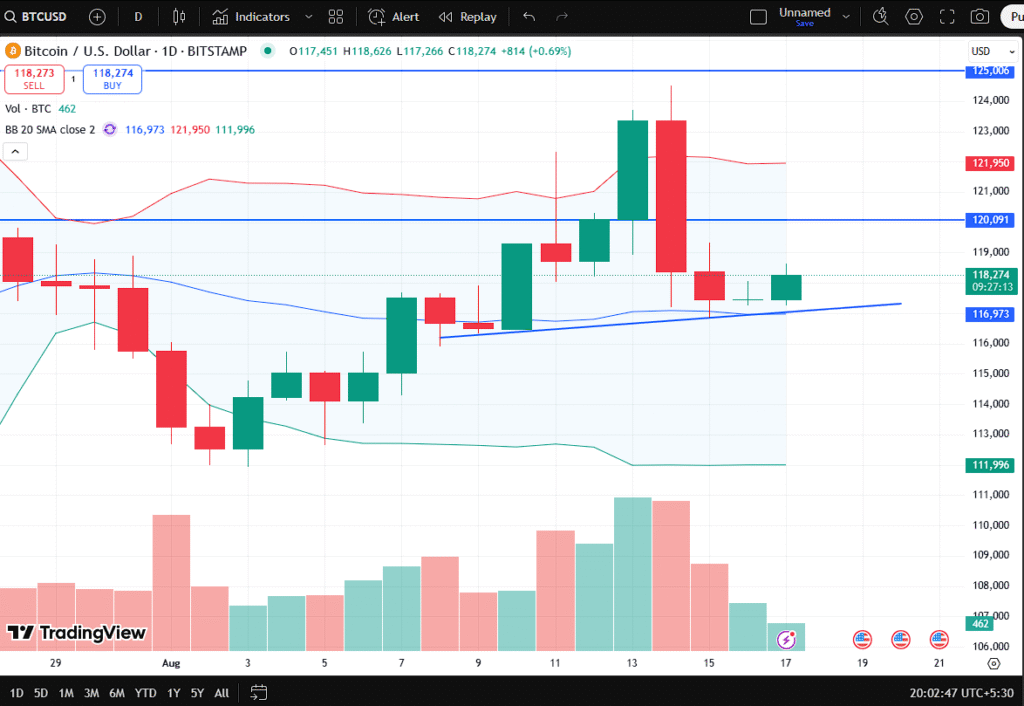Introduction
Is Bitcoin preparing for its next big breakout? With the cryptocurrency market showing heightened volatility in August 2025, traders and long-term investors are closely watching Bitcoin’s price action. The world’s largest digital asset has been consolidating near the $118,000 mark, but recent chart patterns suggest a potential move in either direction.
In this article, we will break down Bitcoin’s historical context, analyze current developments, review technical indicators, and explore market sentiment. We’ll also highlight risks and challenges while presenting possible scenarios for Bitcoin’s future price movement. Whether you are a day trader, long-term investor, or simply crypto-curious, this analysis will give you actionable insights.
Why Bitcoin Is at a Critical Turning Point
Over the years, Bitcoin has experienced multiple boom-and-bust cycles, but 2025 is proving to be a decisive year. After its remarkable rally in late 2024, Bitcoin touched levels above $123,000 before retracing. This retracement is not unusual—it reflects a healthy correction phase that often precedes the next big rally.
Historically, Bitcoin tends to consolidate before major breakouts. Analysts note that consolidation phases near strong support levels often build momentum for upward moves. The $116,000 zone has emerged as a key support, while $120,000 remains the immediate resistance.
Trusted sources like CoinTelegraph and Investopedia highlight Bitcoin’s unique resilience despite regulatory pressures and macroeconomic uncertainty. As inflation concerns linger globally, Bitcoin’s narrative as “digital gold” continues to attract institutional and retail investors alike.
Data & Statistics
- Current Price: $118,235 (as of August 2025)
- 24h Range: $117,266 – $118,626
- Key Support Levels: $116,971, $111,997
- Key Resistance Levels: $120,091, $121,946
- Volume (24h): 463 BTC

Bitcoin price chart showing resistance levels in August 2025.
Current Developments / News
Bitcoin’s recent pullback from $123,000 has caught the attention of analysts. Social media discussions point to strong buying pressure near the $117,000 level, suggesting institutional investors may be quietly accumulating. On-chain data also reveals an uptick in wallet addresses holding significant Bitcoin balances, which could indicate confidence in long-term growth.
Meanwhile, global events continue to impact Bitcoin sentiment. Reports from major financial institutions suggest that Bitcoin ETFs have seen increased inflows, providing additional legitimacy to the asset class. On X (formerly Twitter), crypto influencers are calling this phase a “calm before the storm,” hinting at an upcoming price surge.
For traders, the focus remains on whether Bitcoin can reclaim and hold above $120,000. A daily close above this level could ignite bullish momentum, while failure to hold could lead to deeper corrections.
Technical and Fundamental Analysis
From a technical perspective, Bitcoin is currently trading just above its 20-day Simple Moving Average (SMA) of $116,971. This level acts as a strong support zone. The Bollinger Bands suggest volatility is compressing, which typically precedes a breakout. If the price breaches $120,000 with strong volume, the next target could be $125,000.
On the downside, if Bitcoin fails to defend $116,000, we may see a retest of the $112,000 level. Traders are also keeping an eye on the Relative Strength Index (RSI), which hovers near neutral territory, giving room for both bullish and bearish moves.
Fundamentally, Bitcoin continues to benefit from increasing adoption. With institutional players adding Bitcoin to their portfolios and countries exploring Bitcoin-friendly regulations, the long-term trajectory remains bullish. However, macroeconomic uncertainties, including central bank policies, could create headwinds.
Risks and Challenges
- Regulatory Pressure: Governments worldwide may tighten crypto regulations.
- Market Volatility: Sudden price swings could liquidate leveraged traders.
- Macroeconomic Uncertainty: Rising interest rates or recession fears could affect demand.
- Technical Failures: If Bitcoin breaks below $112,000, bearish sentiment may dominate.
Expert Opinions & Market Sentiment
Leading analysts have shared their perspectives on Bitcoin’s current phase:
- Michael Saylor (MicroStrategy) recently stated that Bitcoin remains the “best-performing asset of the decade,” suggesting that dips should be viewed as buying opportunities.
- Analysts from JPMorgan highlighted in their recent report that Bitcoin could act as a hedge against inflation if current macroeconomic pressures persist.
- Crypto research firm Glassnode noted that long-term holders are accumulating, a historically bullish sign.
Market sentiment remains cautiously optimistic. While short-term traders expect volatility, the broader consensus leans toward Bitcoin eventually breaking higher.
Future Outlook / Predictions
Looking ahead, Bitcoin’s trajectory depends on key breakout levels:
- Bullish Scenario: If Bitcoin closes above $120,000 and sustains momentum, it could rally toward $125,000–$130,000 in the coming weeks.
- Bearish Scenario: Failure to hold $116,000 could push Bitcoin down to $112,000 or lower.
- Neutral Scenario: Bitcoin continues to consolidate between $116,000–$120,000, building momentum for a larger move later in 2025.
Long-term investors remain optimistic, but traders must prepare for volatility as Bitcoin nears critical levels.
Conclusion & Call-to-Action
Bitcoin stands at a pivotal moment in August 2025. With $116,000 as strong support and $120,000 as immediate resistance, traders and investors should closely monitor price action. While risks remain, expert sentiment and on-chain data point toward long-term bullishness.
What do you think—will Bitcoin break past $120,000 or fall back toward $112,000? Share your views in the comments below and check out our related analysis on Ethereum and broader crypto market trends.
Disclaimer: This article is for informational purposes only and should not be taken as financial advice. Always do your own research before making investment decisions.
Oracle Layoffs Hit Cloud Unit Amid AI Investment Surge — What It Means for the Company’s Future





